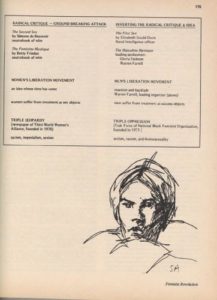Reading Multiracial Feminism: Recasting the Chronology of Second Wave Feminism was insightful and reminded me of Shange’s work. The most interesting part of the paper was when Becky Thompson, the author, talked about the periodization of second-wave feminism.
Thompson says, “Ironically, the very period that white feminist historians typically treat as the period of decline within the movement is the period of mass mobilization among anti-racist women- both straight and lesbian” (Thompson 334). White feminists believed that mass mobilization for feminists issues was at a low in 1982, however, looking at the history of women of color activists and scholars, it’s clear that 1982 was the hight of multiracial feminism.
This was surprising to learn because it made me realize that my understanding of history has been formed through a white lens. It also made me angry because I learned that white women have erased the voices of women of color. It made me think of For Colored Girls Who Have Considered Suicide/When The Rainbow Is Enuf when Shange wrote:
“another song with no singers
lyrics/ no voices
& interrupted solos
unseen performances”
The voices of women of color are always pushed aside to allow white women to be at the center and have control over any narrative.
In Thompson’s article, she talks about how women of color feminist organizations worked together and learned from each other. She says, “As the straight Black women interacted with the Black lesbians, the first generation Chinese women talked with the Native American activists, and the Latina women talked with the Black and white women about the walls that go up when people cannot speak Spanish…” (Thompson 343).
Thompson’s description of how women of color worked together to understand each other’s issues really made me think of how in For Colored Girls Who Have Considered Suicide/When The Rainbow Is Enuf, Shange wrote about women of color coming together to share their stories, understand each other, and form a community. Shange wrote:
“LADY IN BLUE:
i never did like to grind.
LADY IN YELLOW:
what other kind of dances are there?
LADY IN BLUE:
mambo, bomba, merengue . . .
LADY IN YELLOW:
Do you speak spanish?
LADY IN BLUE:
olà”
Although this was not the most prominent part of the Shange’s book, I loved it! The women were directly addressing each other, giving their opinions, and learning. It made me think of Thompson’s quote regarding women of color feminists coming together. It was one of my favorite themes in Shange’s book and it makes me happy to see that this relationship is reflected in the history of feminism.


